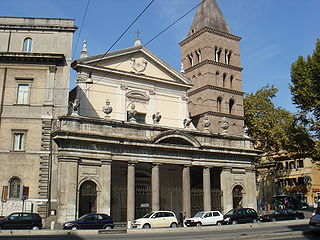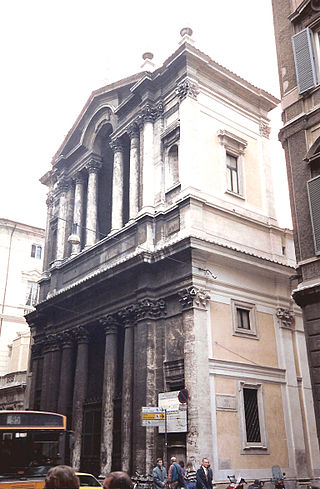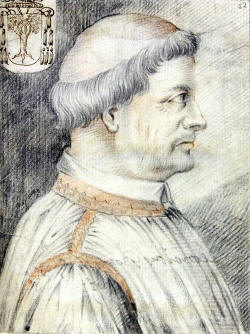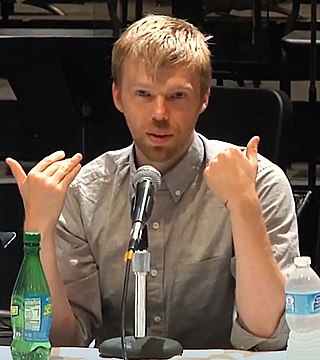
Giuseppe Ottavio Pitoni was an Italian organist and composer. He became one of the leading musicians in Rome during the late Baroque era, the first half of the 18th century.

The Basilica of Saint Clement is a Latin Catholic minor basilica dedicated to Pope Clement I located in Rome, Italy. Archaeologically speaking, the structure is a three-tiered complex of buildings: (1) the present basilica built just before the year 1100 during the height of the Middle Ages; (2) beneath the present basilica is a 4th-century basilica that had been converted out of the home of a Roman nobleman, part of which had in the 1st century briefly served as an early church, and the basement of which had in the 2nd century briefly served as a mithraeum; (3) the home of the Roman nobleman had been built on the foundations of republican era villa and warehouse that had been destroyed in the Great Fire of AD 64.

The Basilica of Saint Mary of the Altar in Heaven is a titular basilica in Rome, located on the highest summit of the Campidoglio. It is still the designated church of the city council of Rome, which uses the ancient title of Senatus Populusque Romanus. The present cardinal priest of the Titulus Sanctae Mariae de Aracoeli is Salvatore De Giorgi.

Cosmatesque, or Cosmati, is a style of geometric decorative inlay stonework typical of the architecture of Medieval Italy, and especially of Rome and its surroundings. It was used most extensively for the decoration of church floors, but was also used to decorate church walls, pulpits, and bishop's thrones. The name derives from the Cosmati, the leading family workshop of craftsmen in Rome who created such geometrical marble decorations.

As the home of the Pope and the Catholic curia, as well as the locus of many sites and relics of veneration related to apostles, saints and Christian martyrs, Rome had long been a destination for pilgrims. The Via Francigena was an ancient pilgrim route between England and Rome. It was customary to end the pilgrimage with a visit to the tombs of Saints Peter and Paul. Periodically, some were moved to travel to Rome for the spiritual benefits accrued during a Jubilee. These indulgences sometimes required a visit to a specific church or churches. Pilgrims need not visit each church.

There are more than 900 churches in Rome, which makes it the city with the largest number of churches in the world. Almost all of these are Catholic.

The Church of Saint Susanna at the Baths of Diocletian is a Roman Catholic parish church located on the Quirinal Hill in Rome, Italy. There has been a titular church associated to its site as far back as AD 280. The current church was rebuilt from 1585 to 1603 for a monastery of Cistercian nuns founded on the site in 1587, which still exists there.

The Cosmati were a Roman family, seven members of which, for four generations, were skilful architects, sculptors and workers in decorative geometric mosaic, mostly for church floors. Their name is commemorated in the genre of Cosmatesque work, often just called "Cosmati", a technique of opus sectile formed of elaborate inlays of small triangles and rectangles of colored stones and glass mosaics set into stone matrices or encrusted upon stone surfaces. Bands, panels and shaped reserves of intricate mosaic alternate with contrasting bands, guilloches and simple geometric shapes of plain white marble. Pavements and revetments were executed in Cosmatesque technique, columns were inlaid with fillets and bands, and immovable church furnishings like cathedras and ambones were similarly treated. Initial inspiration for the technique was Byzantine, transmitted through Ravenna and Sicily, while some of the minutely-figured tiling patterns are Islamic in origin, transmitted through Sicily.

Santi Quattro Coronati is an ancient basilica in Rome, Italy. The church dates back to the fourth or fifth century, and is devoted to four anonymous saints and martyrs. The complex of the basilica with its two courtyards, the fortified Cardinal Palace with the Saint Silvester Chapel, and the monastery with its cosmatesque cloister is built in a silent and green part of Rome, between the Colosseum and San Giovanni in Laterano, in an out-of-time setting.

Santa Cecilia in Trastevere is a 5th-century church in Rome, Italy, in the Trastevere rione, devoted to the Roman martyr Saint Cecilia.

San Marco is a minor basilica in Rome dedicated to Saint Mark the Evangelist located in the small Piazza di San Marco adjoining Piazza Venezia. It was first built in 336 by Pope Mark, whose remains are in an urn located below the main altar. The basilica is the national church of Venice in Rome.

San Crisogono is a church in Rome dedicated to the martyr Saint Chrysogonus. It was one of the tituli, the first parish churches of Rome, and was probably built in the 4th century under Pope Sylvester I (314–335).

Santa Maria in Via Lata is a church on the Via del Corso, in Rome, Italy. It stands diagonal from the church of San Marcello al Corso.
Giovanni Lorenzo Lulier, nicknamed Giovannino del Violone was a Baroque Italian composer, cellist and trombone player of Spanish descent.

The 1086 papal election ended with the election of Desiderius, abbot of Monte Cassino as Pope Gregory VII's successor after a year-long period of sede vacante.

Leonardo Grosso della Rovere was an Italian Roman Catholic bishop and cardinal.

The Palazzo Rusticucci-Accoramboni is a reconstructed late Renaissance palace in Rome. Erected by the will of Cardinal Girolamo Rusticucci, it was designed by Domenico Fontana and Carlo Maderno joining together several buildings already existing. Due to that, the building was not considered a good example of architecture. Originally lying along the north side of the Borgo Nuovo street, after 1667 the building faced the north side of the large new square located west of the new Saint Peter's Square, designed in those years by Gian Lorenzo Bernini. The square, named Piazza Rusticucci after the palace, was demolished in 1937–40 because of the erection of the new Via della Conciliazione. In 1940 the palace was dismantled and rebuilt with a different footprint along the north side of the new avenue, constructed between 1936 and 1950, which links St Peter's Basilica and the Vatican City to the center of Rome.

Andrew Norman is an American composer of contemporary classical music whose texturally complex music is influenced by architecture and the visual arts.
















